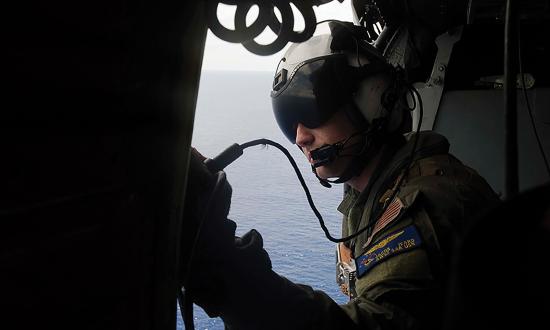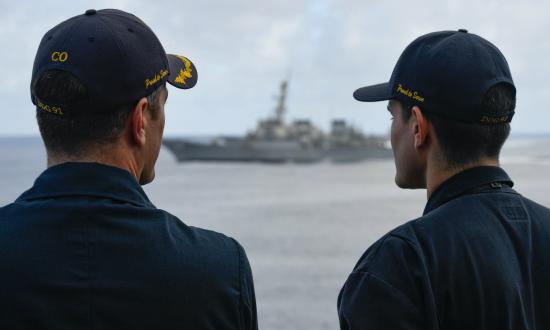Regarding the future of maritime forces, most midshipmen lack sufficient operational experience to envision what those forces should look like. For the vast majority, their only fleet experience is a one-month summer cruise—enough time to get a quick taste of their future careers, but not enough to understand all aspects of fleet life. Midshipmen’s main objective, however, is not to become experts on naval life or global affairs. While those matters are important and should be studied, their primary focus must be how to develop themselves as leaders. When searching for a role model of great naval leadership, midshipmen can see an excellent example in Admiral Horatio Nelson.
Admiral Nelson is considered one of the greatest officers in the history of the Royal Navy. As a leader, he was “known for bold action, and the occasional disregard of orders from his seniors.” Disregarding orders would normally diminish a leader’s reputation; yet, Admiral Nelson managed to lead his ships in destroying Napoleon’s fleet at the Battle of the Nile in 1798 and preventing an invasion of the British mainland by a combined French and Spanish fleet at the Battle of Trafalgar in 1805. His incredible success would be highlighted nearly 100 years after his death by American naval theorist Alfred Thayer Mahan. In his essay, “The Strength of Nelson,” Mahan describes Nelson as someone who “presents a great heroic standard, a pattern … [of] courage, fortitude, [and] zeal.”
These characteristics, however, are not what made Nelson a great naval officer. Instead, Mahan insists that Nelson’s greatest strength was his “inborn natural power to trust.” Trusting in all levels of his chain of command, especially those below him, became his most effective asset in combat. His understanding that he had well-trained sailors and a competent corps of officers made Nelson’s on-the-spot battle plans effective and nearly impossible to counter.
Trusting subordinates is a foundational pillar for the U.S. Navy. When John Paul Jones took command of the Ranger, the orders he received from Congress regarding combat totaled just 196 words. To quote Fleet Admiral Chester Nimitz, “When you’re in command, command.” For nearly the entire war, Jones was in command. He led his ships and his sailors the way he saw best fit and had success against the British fleet. The young U.S. government put its trust in the Scottish captain.
The key lesson of Nelson’s career is that to be an effective leader, you must put faith in your forces. The Naval Academy is a four-year education and training command designed to teach leadership and help midshipmen practice leadership. Unfortunately, trust in subordinates —that key tenet of leadership—is disappearing. Historically, midshipmen would “learn the ropes” at sea to become an officer, holding the responsibility of a modern-day petty officer. Today, however, instead of imbuing midshipmen with lessons in responsibility and confidence, leadership training has been breeding a “Mother, may I?” mentality into future officers.
At Annapolis, nearly all requests and proposals pass through the midshipmen chain of command as a mere formality. Midshipmen have very little say in how to lead their peers. Though there is variance from company to company, some midshipmen unit commanders live and “lead” under constant micromanagement from senior enlisted leaders and company officers.
The Naval Academy command structure and culture currently do not teach the trust necessary to lead 21st-century naval forces. The Senior Enlisted Program, for example, was created in 1994 with the intent of having top senior enlisted from the fleet advise and mentor midshipmen. These mentors were to help provide a foundation on which midshipmen could build, to learn how to interact with the senior enlisted they would soon be leading in the fleet. The program is critical, as the experience and knowledge of senior enlisted is unmatched by anything else the Academy can offer. Despite recommendations to avoid formal roles and responsibilities for the job, however, senior enlisted leaders (SELs) have been put in the midshipmen chain of command. What precedent does this set for future officers and trust? First-class midshipmen who are months from putting on gold bars must gain official approval from their SEL for something as simple as letting a squad go bowling on a Friday night. SELs should advise midshipmen on what might be the best course of action for their squads, and give feedback on how to make the morale event more rewarding for all. But first-class midshipmen should not have to ask permission from their company SELs to lead their squads the way they see fit. Permission should instead come from the midshipmen company commander. In the current command structure, the fear that midshipmen will make a mistake is too overwhelming for a training environment. This is where mistakes should be made, rather than in the fleet.
Another example is the indoctrination of the plebe class. With weekly professional knowledge tests, rigorous academic requirements, and a myriad of additional responsibilities, plebe year is designed to almost overwhelm an individual. To help plebes get through this stressful year, they are assigned a youngster (sophomore) mentor. The youngster mentor is the first person in a plebe’s chain of command. The youngster should, in theory, be responsible for the plebe; and the plebe’s performance, good or bad, should reflect to a certain extent back on the youngster’s mentorship. But this is no longer how the youngster mentor program operates. Often, plebe performance is the responsibility of the plebe’s company training staff.
If trust is to be taught at the Naval Academy, it should start with the youngster mentor program. The midshipmen training officer should push down specific qualifications that the plebes must meet, and it should be the responsibility of the plebes’ midshipmen chains of command to help them achieve those qualifications. From a historical perspective, it was the responsibility of a company’s second class to be the “enforcers” of the rules and train the plebes. This role, as mentioned earlier, now falls mainly on a group of five to eight midshipmen on the company training staff. This model of selective training needs an immediate course correction.
In Lieutenant Commander Stuart Landersman’s “The Damn Exec,” he says an observer can tell the effectiveness of a unit based on what level blame falls on. Landersman explains, “It’s easy to say ‘the exec wants’ or ‘Mr. Jones says.’ It’s the easy, lazy way; not the right way. You can sometimes discuss or even argue with an order, but when you give one to a subordinate, make him think it is an order coming from you.” In other words, in a solid unit, orders will come closer to the bottom of the chain of command. If the Naval Academy is going to teach trust effectively, it needs to encourage and promote implementing a “damn youngster” mentality or, at a minimum, a “damn second class” one. Teach midshipmen to trust taking and giving orders to and from their peers.
Midshipmen will be entering a naval force in a climate much different from the one into which today’s senior officers entered. Great power competition is reaching heights that have not been seen since the Cold War. With the rapidly changing warfighting environment, midshipmen need to have a fundamental grasp on effective leadership. Trust is the foundation of successful team cultures. The ability to trust is something that cannot be taken for granted. Trust between individuals and commands is a relationship that must be constantly worked on, and parties need to put in sufficient time and energy to create a trusting environment. If the Navy wants a combat-ready force capable of winning wars, deterring aggression, and maintaining freedom of the seas, it must start by rethinking how trust is taught to midshipmen.






